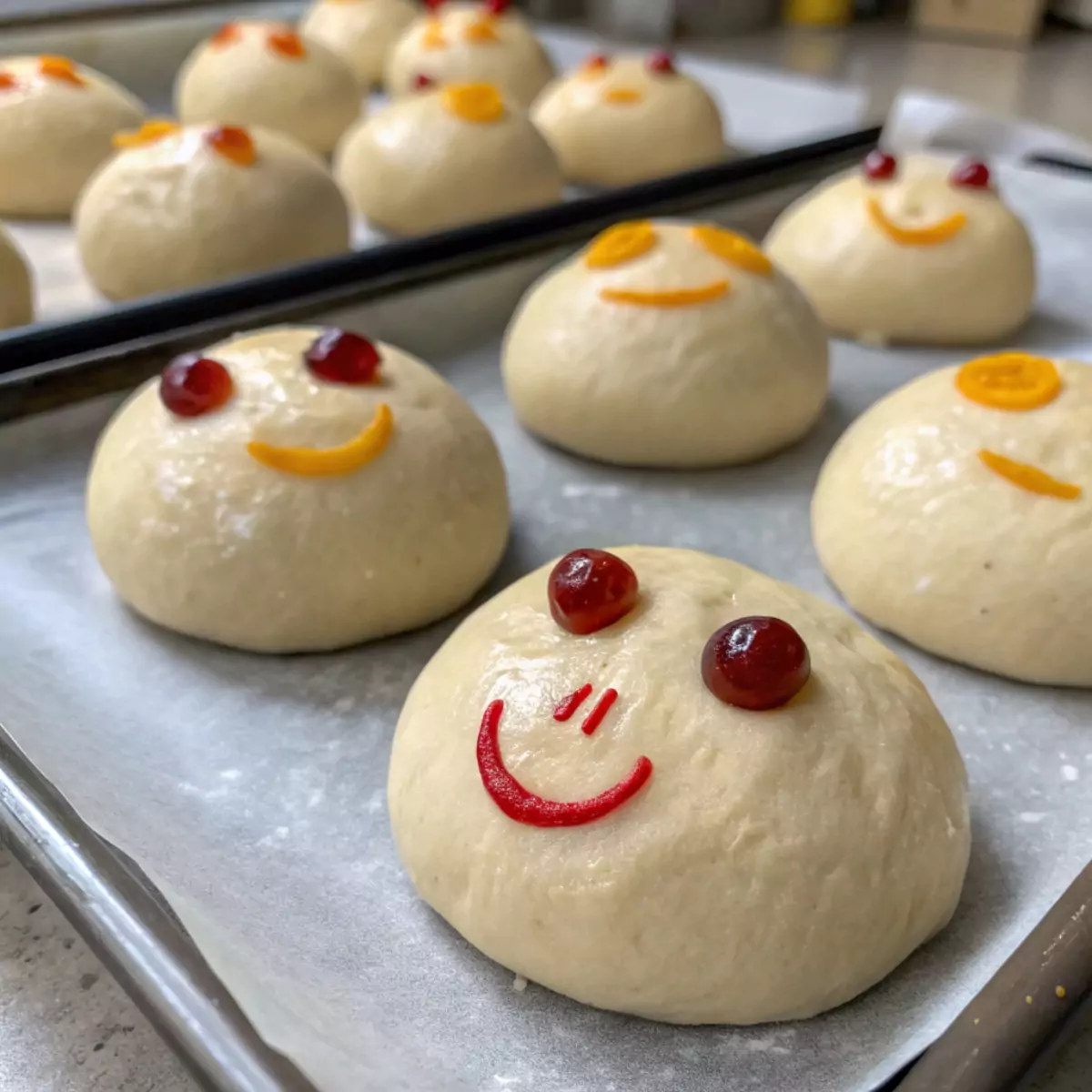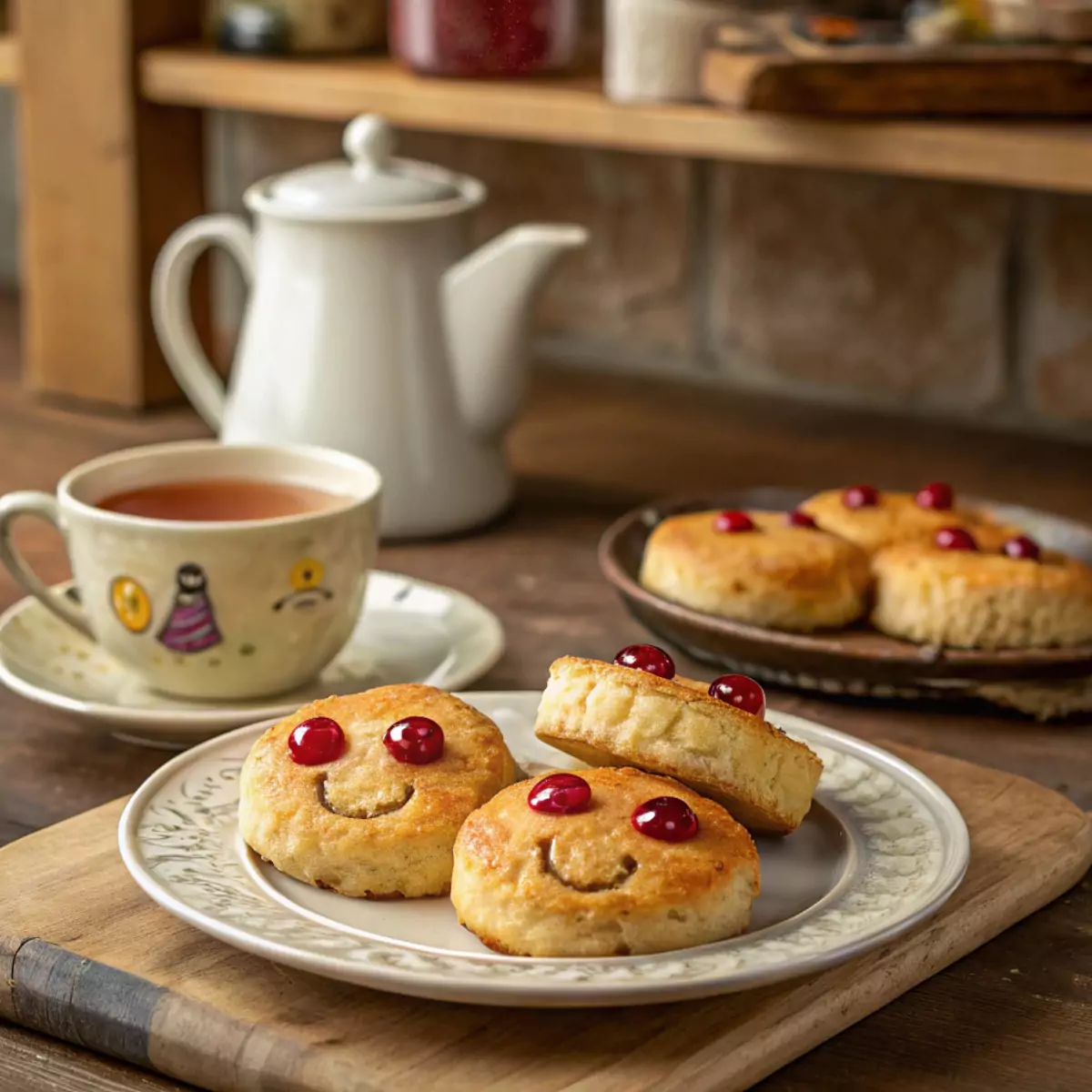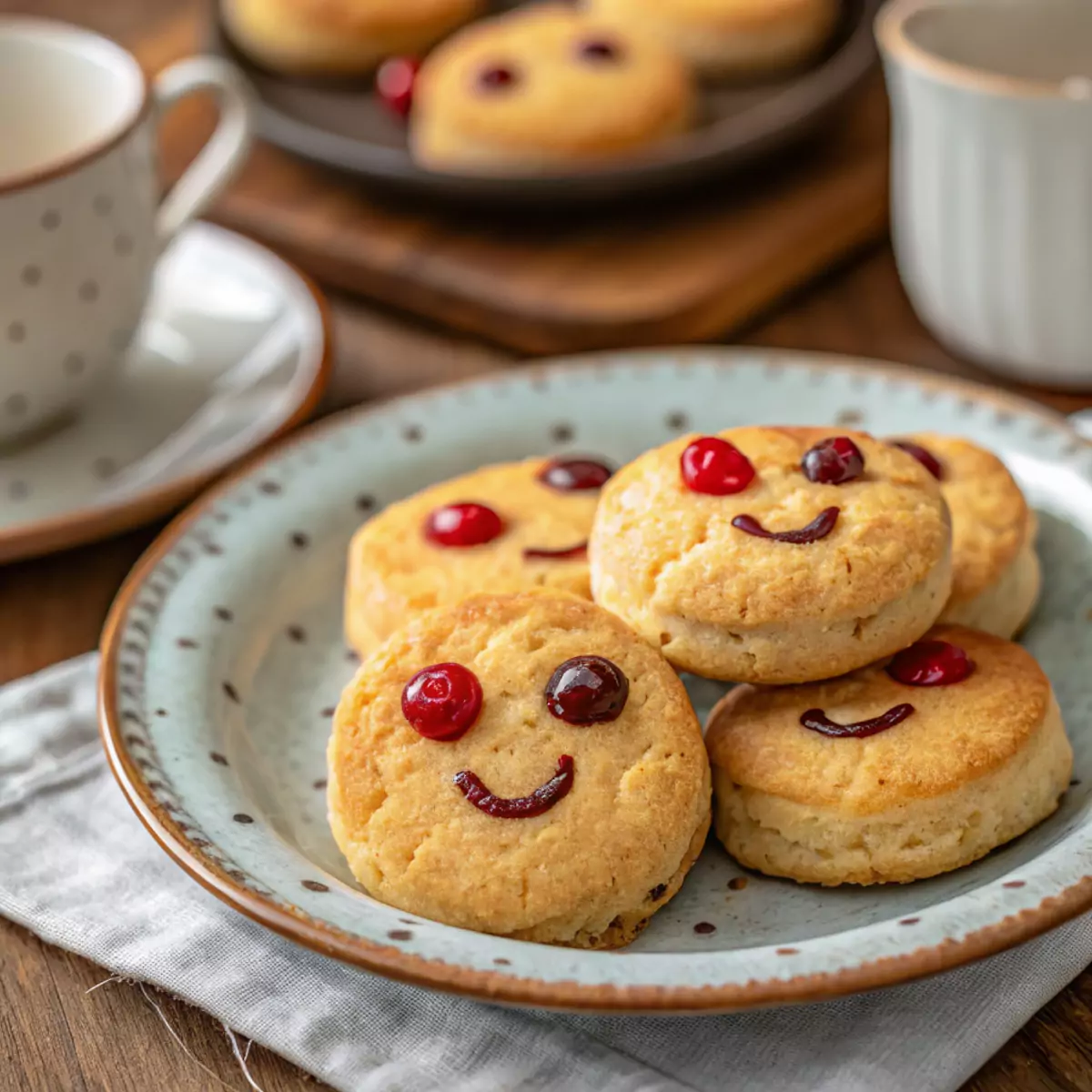There’s something irresistibly cozy about fat rascals. With their golden crust, buttery crumb, and bursts of dried fruit, they’re like a cross between a scone and a rock cake only better. Though relatively unknown outside the UK, fat rascals have been a Yorkshire staple for generations. In this article, we’ll explore the charm of this teatime favorite, discover its true origin, and show you how to enjoy it like a local. Whether you’re recreating Bettys bakery magic at home or trying one for the first time, this guide has everything you need to fall in love with the fat rascal tradition.
The Tale of the Fat Rascal
A crumbly memory from a Yorkshire tearoom
I still remember the first time I bit into a fat rascal. I was in a quaint tearoom in Harrogate, wrapped in a wool coat and warming my hands on a floral china teacup. The server brought out a warm, round bun golden, buttery, and studded with shiny glacé cherries for eyes and a mischievous citrus-peel smile. It looked like a scone but tasted far richer, with a deep, comforting texture and flavor that could only come from generations of tradition.
Fat rascals feel like the kind of baked good you stumble upon by happy accident and then spend years chasing. Luckily, you don’t have to travel to Yorkshire to enjoy them. Today, these rustic treats are making a name for themselves far beyond the UK.
And if you’re into nostalgic bakes like these, you might also enjoy apple pie cinnamon rolls or blackberry cream puffs both cozy and perfect with tea.
Fat rascals and their English origins
The term “fat rascal” has been used in Yorkshire since at least the 19th century, referring to various types of rich tea cakes or buns. Some say it originally described a flat, buttery scone made with leftover pastry trimmings. Others connect it to “turf cakes,” baked on hot stones near the hearth.
Modern fat rascals, however, rose to fame thanks to Bettys Café Tea Rooms, which reimagined them in the 1980s into the plump, fruity domes we know today. Their popularity exploded, and they’ve been a top-seller ever since.
Curious what sets them apart from a muffin or biscuit? Stick around we’ll dig into that next.
Print
Traditional Fat Rascals Recipe
- Total Time: 33 minutes
- Yield: 6 fat rascals 1x
- Diet: Vegetarian
Description
A traditional Yorkshire Fat Rascal recipe golden, buttery, and packed with currants, citrus zest, and a signature smiling face.
Ingredients
2 cups self-rising flour
1 tsp ground cinnamon
1/2 tsp ground nutmeg
1/2 cup cold unsalted butter, cubed
1/4 cup granulated sugar
1/4 cup mixed dried fruit (currants, raisins)
1 tbsp candied citrus peel, chopped
Zest of 1 orange
1 large egg
3 tbsp whole milk
6 glacé cherries (for decoration)
Strips of candied peel (for smile decoration)
1 egg yolk (for egg wash)
Instructions
1. Preheat oven to 400°F (200°C) and line a baking tray with parchment paper.
2. In a large bowl, mix flour, cinnamon, and nutmeg.
3. Rub in butter until mixture resembles breadcrumbs.
4. Stir in sugar, dried fruit, citrus peel, and orange zest.
5. Beat the egg with milk and add to the dry ingredients. Mix to form a soft but not sticky dough.
6. Divide into 4–6 rounds, flatten slightly, and place on baking sheet.
7. Decorate each with two glacé cherry halves (eyes) and a smile of citrus peel.
8. Brush tops with egg yolk for golden finish.
9. Bake for 15–18 minutes until golden and firm.
10. Cool slightly and enjoy warm.
Notes
Best served warm with tea.
Store in airtight container for up to 3 days.
Freeze well for up to 1 month. Reheat before serving.
- Prep Time: 15 minutes
- Cook Time: 18 minutes
- Category: Dessert
- Method: Baking
- Cuisine: British
Nutrition
- Serving Size: 1 bun
- Calories: 285
- Sugar: 18g
- Sodium: 220mg
- Fat: 12g
- Saturated Fat: 7g
- Unsaturated Fat: 4g
- Trans Fat: 0g
- Carbohydrates: 39g
- Fiber: 2g
- Protein: 4g
- Cholesterol: 55mg
Keywords: fat rascals, Yorkshire fat rascal recipe, British buns, teatime treats
Here’s what your fat rascal dough should look like just before baking:

What Exactly Is a Fat Rascal?
Fat rascals vs. scones – is there a difference?
It’s easy to mistake a fat rascal for a scone at first glance. After all, they’re both golden, round, and perfect with tea. But once you take a bite, you’ll notice the differences right away.
Fat rascals are richer and denser than scones, with more butter and a heartier bite. While scones are often flaky and served with cream and jam, fat rascals come fully loaded with dried fruits like currants and sultanas, plus zesty peel and a crunchy, sugary top. Their dough is stiffer, too, giving them that signature dome shape.
Most importantly, fat rascals are never split and filled they’re meant to be enjoyed whole, much like a treat from the past that doesn’t need any dressing up. This makes them more like a cousin to rock cakes or tea buns than a traditional cream tea scone.
Looking for similar bakes? These mini chocolate chip muffins also bring a chewy, dense texture that’s just as satisfying.
What makes them unique (flavor, texture, topping)?
Every fat rascal has three key traits: a rich buttery base, bold bursts of fruit, and that charming face made with cherries and peel. The texture is almost cookie-like crisp at the edges but tender inside. The butter content gives them a satisfying crumble that melts in your mouth.
Orange zest or mixed spice is sometimes added for extra warmth. The top is brushed with egg and sprinkled with demerara sugar, which adds crunch and a little sparkle something that sets them apart visually and in texture.
And while some prefer modern versions with dried cranberries or chocolate chips, we say stick with tradition. Or try them alongside something creative like these courgette and chocolate muffins for a playful twist on rustic baking.
How to Enjoy and Serve Fat Rascals

When and how to eat a fat rascal
If you’re wondering how to enjoy a fat rascal the right way don’t overthink it. These plump, golden buns were made for slow mornings and indulgent afternoons. Traditionally served warm, they shine brightest at teatime, often accompanied by a strong Yorkshire brew or a generous mug of Earl Grey.
There’s no slicing or spreading required just grab one, break it open, and take a bite. The outer crust offers a slight crunch, while the inside is soft, buttery, and packed with sweet fruit. That contrast in textures is part of their charm.
Want to elevate the experience? Try gently reheating one in the oven for 5–6 minutes at 300°F. A touch of warmth brings the buttery aroma back to life almost like it’s fresh out of the oven. Add a dab of salted butter if you’re feeling extra indulgent, though most purists enjoy them plain.
These are just as cozy and satisfying as a slice of pumpkin banana bread perfect for quiet moments or sharing over conversation.
Pairings and reheating tips
Fat rascals pair beautifully with tea, coffee, or even mulled cider on chilly days. Because of their richness, they’re a one-and-done kind of treat not overly sweet but hearty enough to satisfy.
If you’re serving them at brunch or a holiday spread, consider placing them in a warm basket with a linen cloth to keep them soft. They also freeze well; just wrap individually and thaw at room temp before warming gently.
And for a modern take, you could serve them alongside vegetarian cinnamon sugar donut muffins or strawberry cake pops to create a dessert board that blends tradition with fun.
All About Bettys Fat Rascals
Bettys of Harrogate – the bakery that made them famous
While fat rascals have Yorkshire roots going back centuries, it was Bettys Café Tea Rooms in Harrogate that turned them into a national obsession. In the 1980s, Bettys reimagined this old-school bun into a richer, more whimsical version complete with cherry eyes and citrus peel smiles. Their iconic take became so beloved that it’s now trademarked, and it sells out daily at their bakeries.
Locals and tourists alike flock to Bettys just to get their hands on one. But what makes their fat rascals so addictive? It’s the perfect balance crisp on the outside, soft in the center, and brimming with juicy fruit and warm spice. They’re large enough to share (though you won’t want to), and just one can turn a regular afternoon into a full-on treat.
This level of regional fame reminds me of how something as nostalgic as a Woolworth cheesecake can bring people back through doors over and over again.
Making a Bettys-style fat rascal at home
Luckily, you don’t have to travel to Harrogate to experience this teatime treasure. With a few pantry staples and the right method, you can bake fat rascals in your own kitchen that rival Bettys’ version.
Start with a rich dough made of self-rising flour, cold butter, and a little sugar. Add mixed spice or cinnamon, then fold in dried fruit currants, sultanas, and chopped peel are essential. Once shaped, brush the tops with egg wash and decorate with glacé cherries and orange or lemon peel to form that smiling face.
Bake until golden and fragrant, then enjoy while still warm. Pair one with a homemade cup of tea or something fruity like this banana pudding cheesecake for a blend of comfort and indulgence.
FAQ About Fat Rascals
Where do Fat Rascals come from?
Fat rascals originated in Yorkshire, England, dating back to the 1800s. Originally, the term referred to rustic, buttery buns made with leftover pastry bits. They evolved into plump, fruity tea cakes and gained iconic status after being popularized by Bettys Café Tea Rooms in Harrogate.
How do you eat Fat Rascals?
Traditionally, you eat fat rascals warm, straight from the oven or gently reheated. There’s no need for butter or jam they’re rich and flavorful on their own. Just break them open and enjoy with tea or coffee.
Is a Fat Rascal a scone?
Not quite. While fat rascals share a similar shape and baking method, they are richer, denser, and more buttery than a scone. They’re also topped with cherries and citrus peel, unlike scones which are typically served plain or with spreads.
What are Bettys Fat Rascals?
Bettys Fat Rascals are a trademarked version created by the famous Bettys Café Tea Rooms. Their version is large, dome-shaped, loaded with dried fruits, and finished with a charming cherry-and-peel face. It’s become a bakery legend and a beloved British treat.
Fat rascals may have humble roots, but their warm, buttery richness has made them a teatime treasure. Whether you’re biting into one at Bettys or baking a batch at home, they bring a sense of joy, history, and comfort with every crumb. With their unique flavor, playful appearance, and cozy texture, fat rascals are the kind of treat that turns a simple cup of tea into something truly special. Give them a try and don’t be surprised if they become your new favorite bake.

